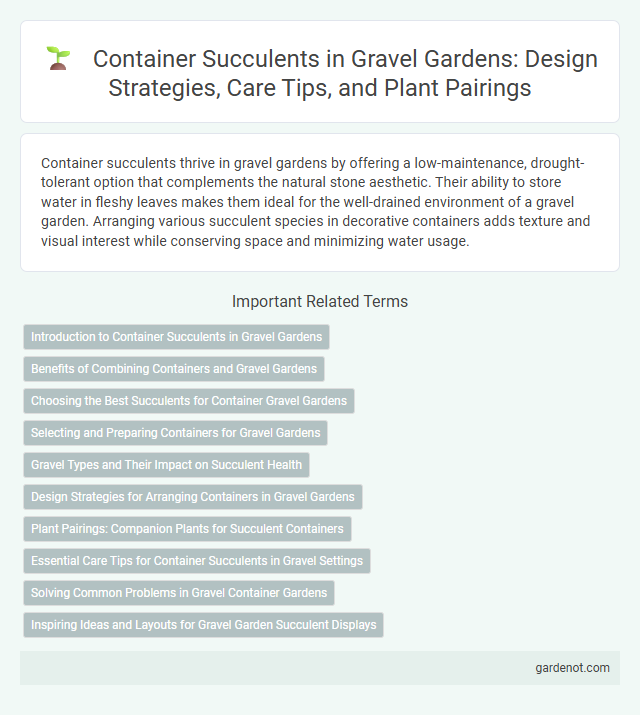Container succulents thrive in gravel gardens by offering a low-maintenance, drought-tolerant option that complements the natural stone aesthetic. Their ability to store water in fleshy leaves makes them ideal for the well-drained environment of a gravel garden. Arranging various succulent species in decorative containers adds texture and visual interest while conserving space and minimizing water usage.
Introduction to Container Succulents in Gravel Gardens
Container succulents thrive in gravel gardens due to their adaptability to well-drained, arid environments that mimic their natural habitats. These drought-tolerant plants require minimal water, making them ideal for sustainable container gardening with gravel substrates that enhance moisture retention and airflow. Selecting diverse succulent varieties like Echeveria, Sedum, and Aloe adds texture and color contrast, promoting an aesthetically pleasing and low-maintenance garden design.
Benefits of Combining Containers and Gravel Gardens
Combining container succulents with gravel gardens enhances water drainage and reduces soil erosion, creating an ideal environment for drought-tolerant plants. This method allows for easy mobility and customization of plant arrangements, providing flexibility in garden design. Additionally, containers help isolate plant diseases, promoting healthier growth in gravel garden settings.
Choosing the Best Succulents for Container Gravel Gardens
Selecting the best succulents for container gravel gardens involves considering drought tolerance, size, and growth habits to ensure a thriving display. Species such as Echeveria, Sedum, and Crassula are ideal due to their adaptability to well-drained, gravelly soil and low water requirements. Prioritizing succulents with varied textures and colors enhances visual interest while supporting sustainable, low-maintenance gardening practices.
Selecting and Preparing Containers for Gravel Gardens
Choosing containers with adequate drainage holes is crucial for container succulents in gravel gardens to prevent waterlogging and root rot. Opt for porous materials like unglazed terra cotta or concrete, which facilitate airflow and moisture regulation. Before planting, fill the container's base with a layer of gravel or coarse sand to enhance drainage and mimic the natural gravel garden environment.
Gravel Types and Their Impact on Succulent Health
Gravel types such as pea gravel, crushed stone, and lava rock significantly influence container succulent health by improving drainage and preventing root rot. Coarse gravel enables airflow around roots, reducing moisture retention that can cause fungal issues. Choosing the appropriate gravel type tailored to succulents' drought-tolerant nature supports optimal growth and longevity.
Design Strategies for Arranging Containers in Gravel Gardens
Container succulents thrive in gravel gardens due to their drought tolerance and low maintenance needs, making them ideal for strategic placement in sunny, well-drained areas. Design strategies include grouping containers by size and texture to create visual interest, using contrasting colors and forms to enhance the gravel backdrop, and incorporating varying heights to add depth and dimension. Selecting containers with neutral tones or natural materials like terracotta complements the gravel's earthy aesthetic while ensuring the succulents remain the focal point.
Plant Pairings: Companion Plants for Succulent Containers
Succulent containers thrive when paired with drought-tolerant plants like sedum, echeveria, and sempervivum, which share similar water and sunlight needs. Low-maintenance companions such as ornamental grasses and lavender enhance texture and color contrast while thriving in well-drained, gravel garden soil. Combining these species ensures a resilient, visually appealing succulent container arrangement that conserves water and requires minimal upkeep.
Essential Care Tips for Container Succulents in Gravel Settings
Container succulents in gravel garden settings require well-draining soil and infrequent watering to prevent root rot and ensure healthy growth. Placing containers in locations with ample sunlight, typically six hours daily, supports optimal photosynthesis and vibrant foliage. Regularly removing debris and inspecting for pests helps maintain plant vitality and prevents disease in gravel-based container environments.
Solving Common Problems in Gravel Container Gardens
Container succulents thrive in gravel garden settings by ensuring well-draining soil to prevent root rot, a common issue caused by excess moisture. Proper placement in areas with ample sunlight helps avoid etiolation, where plants become leggy and weak due to insufficient light. Regularly inspecting for pests like mealybugs and aphids is essential in maintaining plant health within gravel containers.
Inspiring Ideas and Layouts for Gravel Garden Succulent Displays
Container succulents thrive in gravel garden settings due to excellent drainage and minimalist aesthetics, making them ideal for creative display layouts. Use shallow, wide containers filled with a mix of gritty soil and gravel to enhance root health and visual appeal. Arranging succulents by varying heights, textures, and colors against gravel backgrounds creates dynamic, low-maintenance garden focal points.
Container succulent Infographic

 gardenot.com
gardenot.com